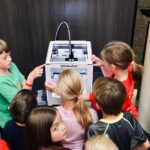Approximately 13% of American public school students have special needs, such as speech-language issues and autism. Assistive technology can offer them new opportunities. Virtual learning and tools mean special-education students needn’t be separated from their classmates. Tools such as adaptive reading assistants and text-to-speech apps often can help special-education students participate in general education classrooms.
Students and educators use various tech tools to reduce anxiety, ease communication, enhance connections with peers, improve academic performance and allow more independence.
Virtual learning during the pandemic made some sea changes for families of special-education students. They found that having video-chat meetings with teachers about students’ Individualized Education Plans was much easier in terms of work schedules and interruptions. Video chats, texting and other types of technology have helped parents of special-education students feel more empowered and connected, research analyst Lanya McKittrick told EdSurge.
Special education may be facing shortage of teachers, but educators dedicated to students with special needs are getting more recognition. This month, EdTech’s 30 K–12 IT Influencers to Follow in 2022 included special-education teacher Kyle Anderson of the Clark County School District in Nevada. Anderson also is a blogger and podcaster.
Schools get creative to assist special-ed students
Creativity is nothing new in special education, and several schools are exemplars.
Students in a California high school’s Growing Hope program use smartphones, tablets, video editing software and sensors to monitor and manage a high-tech greenhouse. “These skills are transferable,” educator Barbara Pastuschek says. “When students are learning to maintain high-end, expensive equipment, that’s transferable to other industries like technology, nutrition, healthcare and hospitality. It’s not just limited to being a farmer or working with hydroponic systems.”
A California elementary school has been using a special communication tool with one student who can’t talk and uses a wheelchair. This new technology allows the 12-year-old to speak with his eyes.
Touchscreens introduced in a Georgia school district help students with disabilities respond easier and faster. This gives them more time with occupational therapists and speech pathologists and improving outcomes.
A New Hampshire school has been using virtual reality headsets to help students who have trouble regulating emotions, physiology and senses. They also assist students with limited mobility. Instructors have found that pre-teaching students about what the VR experience will be like improves success.
Putting more aids in reach of more students

Many people think all special-education students struggle with learning. Others know that challenging STEM subjects are not out of reach for all students who have disabilities or are neurodiverse. Students at the University of Louisville have been creating and 3D-printing tools to help those with visual impairments more easily study STEM. Assistant engineering professor Vance Jaeger notes that his students can change small aspects of a tool’s design to “really make them accessible for people with disabilities.”
When the pandemic made in-person learning difficult, many teachers worked to adapt online learning for students of all abilities and learning styles. They have embraced project-based learning, Universal Design for Learning and Modern Classroom Project standards.
Texthelp CEO Martin McKay says Universal Design for Learning and a host of tools are useful to students who need special education as well as English-language learners. McKay has talked about word prediction devices for students with dyslexia, talking dictionaries, screen masking, speech input tools and much more.
Special ed technology continues to grow
Highly useful adaptive reading assistants seem old-school when compared to forthcoming products. Startup companies are creating new technology all the time. For example, Amplio blends natural language processing, artificial intelligence and evidence-based methodologies to provide educators with structured protocols and learning paths. These let instructors better help students who have speech-language impairments.
Humanlike, nonjudgmental social robots can help improve educational and social skills for many. This includes children who have autism, Down syndrome, hearing impairments and attention-deficit/hyperactivity disorder. They’re primarily for home use now, but researchers hope to find ways to use them in schools.
Technology continues to make vital differences for many students with special needs. But the teachers behind the tech and the students using it are the real successes. Former student Trevor Venomon-Holt recalled K-12 special-education teacher Allison Wootton in a recommendation letter for teacher of the year. “I’m a better person, college student, and independent blind man because of you,” he said.
Original post here


0 Comments